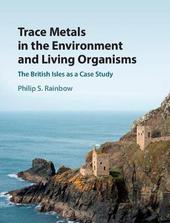
|
Trace Metals in the Environment and Living Organisms: The British Isles as a Case Study
Hardback
Main Details
| Title |
Trace Metals in the Environment and Living Organisms: The British Isles as a Case Study
|
| Authors and Contributors |
By (author) Philip S. Rainbow
|
| Physical Properties |
| Format:Hardback | | Pages:756 | | Dimensions(mm): Height 253,Width 193 |
|
| Category/Genre | Applied ecology
Rocks, minerals and fossils
The Earth - natural history general |
|---|
| ISBN/Barcode |
9781108470933
|
| Classifications | Dewey:572.51 |
|---|
| Audience | | Professional & Vocational | |
|---|
| Illustrations |
Worked examples or Exercises; 130 Tables, black and white; 48 Plates, color; 12 Halftones, black and white; 84 Line drawings, black and white
|
|
Publishing Details |
| Publisher |
Cambridge University Press
|
| Imprint |
Cambridge University Press
|
| Publication Date |
23 August 2018 |
| Publication Country |
United Kingdom
|
Description
Trace metals play key roles in life - all are toxic above a threshold bioavailability, yet many are essential to metabolism at lower doses. It is important to appreciate the natural history of an organism in order to understand the interaction between its biology and trace metals. The countryside and indeed the natural history of the British Isles are littered with the effects of metals, mostly via historical mining and subsequent industrial development. This fascinating story encompasses history, economics, geography, geology, chemistry, biochemistry, physiology, ecology, ecotoxicology and above all natural history. Examples abound of interactions between organisms and metals in the terrestrial, freshwater, estuarine, coastal and oceanic environments in and around the British Isles. Many of these interactions have nothing to do with metal pollution. All organisms are affected from bacteria, plants and invertebrates to charismatic species such as seals, dolphins, whales and seabirds. All have a tale to tell.
Author Biography
Philip S. Rainbow has more than forty years' experience of research into the biology of trace metals. As lecturer, reader and professor at Queen Mary University of London, he taught students at undergraduate, Master's and Ph.D. levels, and often ran courses overseas. From 1997 to 2013, he was Keeper of Zoology and subsequently Head of the Department of Life Sciences, at the Natural History Museum, London. He has published more than 250 refereed scientific publications, including two co-authored and seven edited books, and also upwards of thirty popular articles. In 2002, he was awarded the Environmental Pollution Kenneth Mellanby Review Award.
Reviews'After introductory chapters describing the origins of environmental trace metals from mining and industrialization, the author devotes individual chapters to the resulting biological effects on the flora and fauna in the British Isles' terrestrial, freshwater, estuarine, and coastal environments. Each chapter begins with several pages of definitions for the various specialized terms in the material that follows, which should be very helpful for readers who have limited background in this subject. The approach is multidisciplinary, with the emphasis on biology, and the organisms discussed range from bacteria and plants to whales. The writing is aimed at general readers and should be accessible to readers with some introductory science background.' H. E. Pence, Choice
|